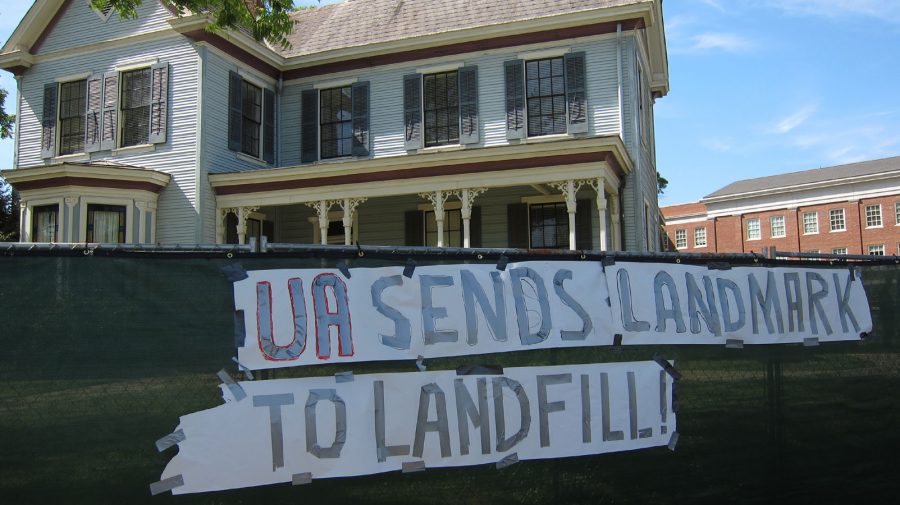Demolition of the Kilgore House on the University of Alabama campus began Monday afternoon, sparking controversy about The University of Alabama’s role in preserving its own history.
Originally built in 1890 by the trustees of Bryce Hospital for Assistant Steward Charles C. Kilgore, the house served as co-ed student housing in the early 1900s. Anna Hunter, the first female faculty member at the University, supervised the students living in the home.
Cathy Andreen, director of University Relations, said now the land will be used for a new outdoor student plaza and an extension of the Fresh Foods dining pavilion.
“I think the demolition of the Kilgore House was a terrible loss for the University and also Bryce Hospital,” said Robert Mellown, associate professor of art history emeritus at the University. “Demolishing a historic building with many important historical and architectural links to the history of both The University of Alabama and to Bryce Hospital is, in my opinion, shocking. Replacing it with an outdoor food court leaves me speechless.”
Mellown, who is working on a book of the architectural history at UA, said the University has been working on plans to ensure protection of historical sites on campus. However, he said the plans are on paper and not in practice, as seen from Tuesday’s demolition.
“These guidelines also emphasize ‘green solutions’ whenever possible — sending a 123-year-old house to a landfill is not one of them,” Mellown said.
The Kilgore House, which stood behind Rodgers Library, was originally put on the market in June 2012. When no one bought the house, it was put up for auction. However, the University still did not manage to find a home for the building.
“Because of its age and size and the way the house was originally constructed, it was not feasible to restore the Kilgore House for University use,” Andreen said. “For the last year, the University has sought a buyer who would purchase the house and move it to another location; however, no one came forward to purchase it.”
Due to the building’s historic significance, the demolition plans have angered many local citizens who wonder how far the University will go to expand and modernize its campus.
“The evolution and growth of The University of Alabama is phenomenal,” Tuscaloosa native Elizabeth Stanard said. “However, progress should not negate the legacy we’ve built.”
Michael Dewar, a 2011 UA graduate, said he is opposed to the demolition of the house.
“It seems a cruel irony — especially during the administration of our first female president — for the strongest remaining link to the struggle of UA’s women for equal access to be demolished because of the pressing need for an outdoor dining hall plaza,” Dewar said. “The architectural beauty and history exemplified in this landmark would do eminently more to enrich the lives and minds of students than any dining hall patio.”
Suzanne Wolfe, who is involved with Preserve Tuscaloosa, an organization determined to maintain and preserve historic structures in Tuscaloosa, said she and Mellown worked for months to try and save the Kilgore House by appealing to the University’s Board of Trustees.
“I am appalled by the UA administration’s decision to raze the Kilgore House,” Wolfe said. “It’s very rare that you find a so-called flagship university tearing down its historic buildings. The trustees are charged with guarding the institution and its traditions, and in this instance they have failed the University and the people of Alabama miserably.”
For years, the Kilgore House was home to the Alabama Heritage magazine, which features stories on historical sites and people in Alabama. When the house was put up for sale last summer, the magazine moved to a building in Northport, Ala.
Rebecca Minder, the digital media editor of Alabama Heritage, said it is “bittersweet” to see the house go.
“The house itself was in very poor condition, and it was not going to be able to be moved safely,” Minder said. “Because of some of the structural issues with the house, it probably would have caved in on itself if it had gone too far.”
Minder said a portion of the house, a schoolhouse originally used by Charles Kilgore’s wife to teach classes, would remain on the land.
“You become very attached to it because it is actually a home,” Minder said. “It’s not a corporate office like the other departments would be in. It’s more cozy.”
The weekend prior to the demolition of the house, protest signs reading “UA Sends Landmark to Landfill!” and “Shame On UA!!” were plastered on the green tarp surrounding the site. Nonetheless, the demolition went ahead as scheduled.
Tim Higgins, a founder of Preserve Tuscaloosa, said although local preservation groups like Alabama Heritage and the Jemison-Van de Graaff Mansion were able to save a few of the artifacts in the house, most of the architecture will be lost in the demolition.
Higgins said locals are often under the false assumption that if a building is old, it is automatically protected from being torn down.
“The city of Tuscaloosa and the University are married to each other indefinitely,” Higgins said. “[However], what we need to do is maintain our historic assets — it’s not about trends, it’s about what’s lasting. Kilgore represents a period of history that’s really just gone now.”









